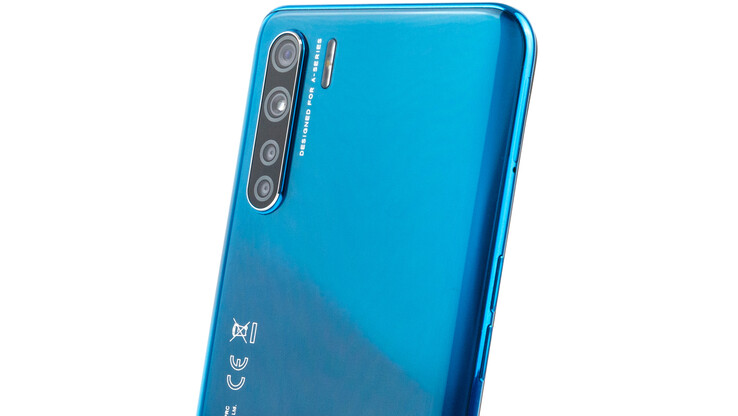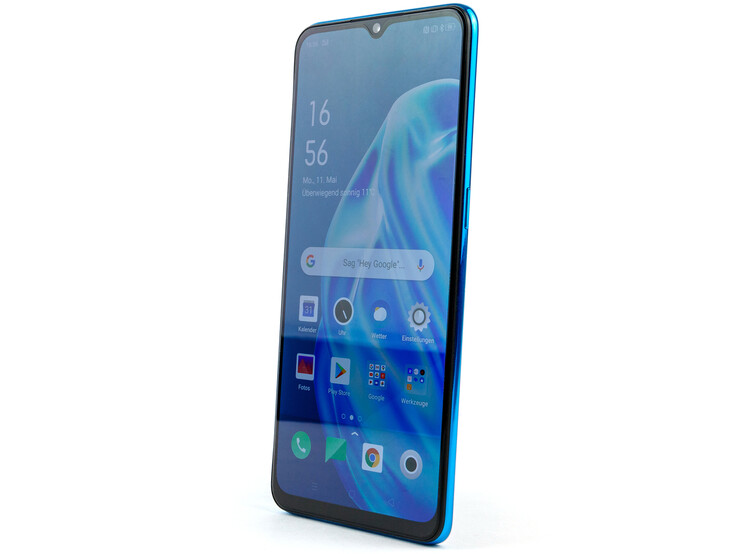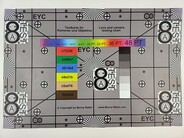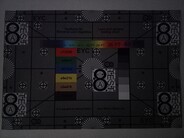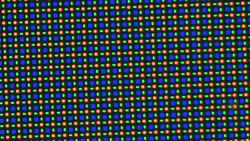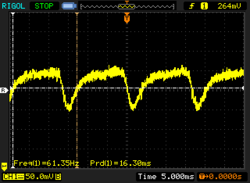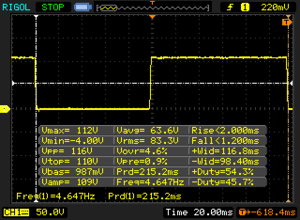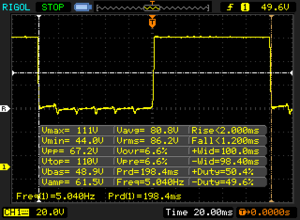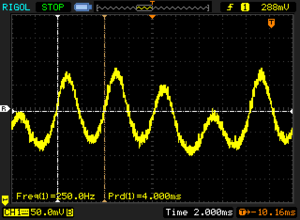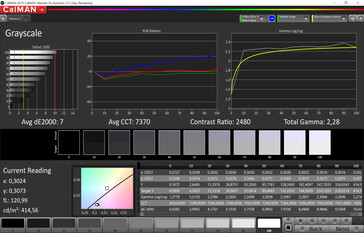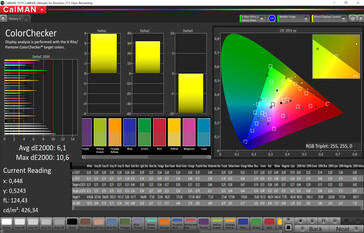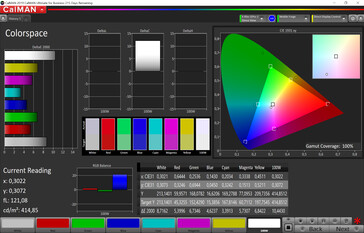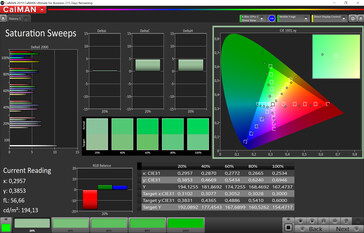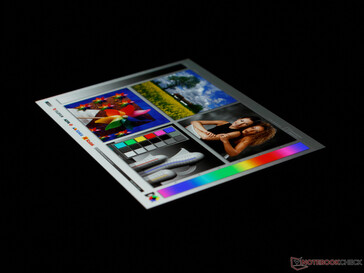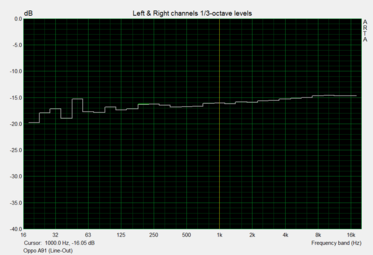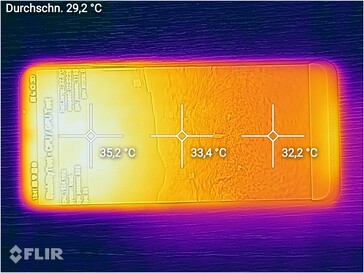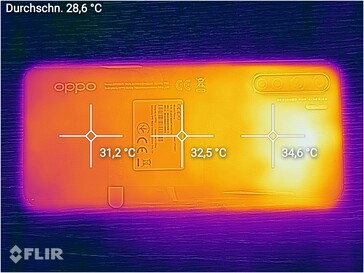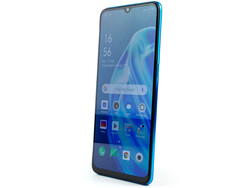Oppo A91 Review - Slim Smartphone with Large Display
Comparison devices
Bewertung | Rating Version | Datum | Modell | Gewicht | Laufwerk | Groesse | Aufloesung | Preis ab |
|---|---|---|---|---|---|---|---|---|
| 79.8 % v7 (old) | v7 (old) | 05 / 2020 | Oppo A91 Helio P70, Mali-G72 MP3 | 172 g | 128 GB UFS 2.0 Flash | 6.40" | 2400x1080 | |
| 81.3 % v7 (old) | v7 (old) | 04 / 2020 | Huawei P40 Lite Kirin 810, Mali-G52 MP6 | 183 g | 128 GB UFS 2.1 Flash | 6.40" | 2310x1080 | |
| 78.1 % v7 (old) | v7 (old) | 03 / 2020 | Motorola Moto G8 Power SD 665, Adreno 610 | 197 g | 64 GB eMMC Flash | 6.40" | 2300x1080 | |
| 79.8 % v7 (old) | v7 (old) | 01 / 2020 | Samsung Galaxy A51 Exynos 9611, Mali-G72 MP3 | 172 g | 128 GB UFS 2.0 Flash | 6.50" | 2400x1080 |
Case, equipment and operation
Despite its size and strong battery, the Oppo A91 is comparatively light, mainly due to the absence of glass and the reduced use of aluminium. The materials are replaced by plastic. This does not diminish the smartphone's valuable impression, as the workmanship is on a good level and the gaps are both tight and even. There is no special protection against the penetration of dust and water and the battery is firmly installed.
The features are on a similar level to those of analog expensive competitor models, but Oppo also gives the A91 a fingerprint scanner in the display and a potent quick charge technology.
Android 9.0 Pie with the in-house ColorOS 6.1 is still used as operating system. An update to Android 10 with ColorOS 7 is planned for next August. The security patches for our test device are from April 5th, 2020 and the manufacturer is aiming for quarterly updates.
Mobile, the Oppo smartphone only gets into the data network with LTE Cat. 7 at best and has a decent frequency equipment, with which there shouldn't be any bottlenecks within Europe. The user has a full dual SIM at his disposal. The A91 was inconspicuous during mobile phone use, unfortunately this is not the case with the WLAN module, which, in combination with our reference router Netgear Nighthawk AX12, shows clear drops in the reception of data.
The Oppo A91 offers good system performance and smooth operation. The fingerprint scanner and face recognition work smoothly in the test and deliver good recognition rates.
The speech quality of the Oppo A91 is quite good when held to the ear, as long as the speaker does not speak too loudly into the microphone, because then audible clipping occurs. Ambient noise is filtered out as much as possible, but the intelligibility of the user suffers as well, which is occasionally interrupted and slightly distorted by small dropouts. We positively like the loudspeaker function, which has a good range and only minimally dampens the speaker. WLAN calling is supported by the A91, but VoLTE isn't.
| Networking | |
| iperf3 transmit AX12 | |
| Huawei P40 Lite | |
| Oppo A91 | |
| Samsung Galaxy A51 | |
| Motorola Moto G8 Power | |
| iperf3 receive AX12 | |
| Samsung Galaxy A51 | |
| Huawei P40 Lite | |
| Oppo A91 | |
| Motorola Moto G8 Power | |
Cameras - Oppo A91 with four peepholes
A quad camera sounds like a powerful piece of equipment, but the two 2-MP lenses only collect additional information for monochrome or portrait shots. The 8-MP wide-angle lens is not an ultra-wide-angle lens, but supports the main camera in macro shooting (3 cm), which works well in everyday life. The 48 MP lens takes good pictures in daylight and is supported by numerous AI features, but it does tend to overdo it with the HDR function. Given the price range, the low-light characteristics are also satisfactory.
Videos can be recorded in Full HD and are stabilized by an effective EIS.
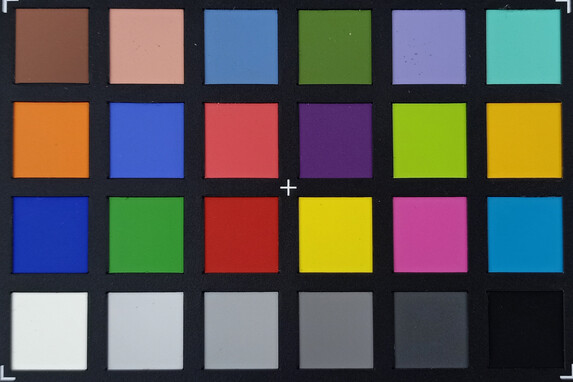
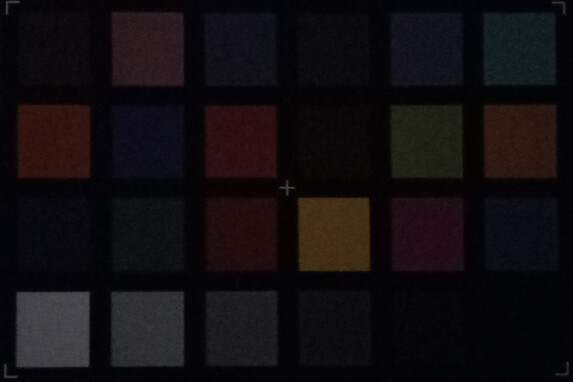
Display - AMOLED with DC-Dimming 2.0
The 6.4-inch AMOLED display of the Oppo A91 offers high pixel density and is protected by Corning Gorilla glass 5. With the ambient light sensor activated, the brightness climbs up to 594 cd/m² on a pure white area in the centre of the image, and even 797 cd/m² with an even distribution of light and dark areas (APL50). On the other hand, those who want to control the brightness manually will only achieve 415 cd/m². The smartphone performs well outdoors and remains easy to read in most lighting situations.
For PWM-sensitive people, Oppo also offers flicker reduction (DC dimming) in version 2.0. This reduces the flicker to a constant 60 Hz, but is intended to increase the image noise. Without this function the frequency fluctuates between 136 and 250 Hz.
The values determined with CalMAN for the color display of the panel are at a decent level and can be adjusted to your own requirements in the settings.
| |||||||||||||||||||||||||
Brightness Distribution: 89 %
Center on Battery: 594 cd/m²
Contrast: ∞:1 (Black: 0 cd/m²)
ΔE ColorChecker Calman: 6.1 | ∀{0.5-29.43 Ø4.78}
ΔE Greyscale Calman: 7 | ∀{0.09-98 Ø5}
100% sRGB (Calman 2D)
Gamma: 2.28
CCT: 7370 K
| Oppo A91 AMOLED, 2400x1080, 6.4" | Huawei P40 Lite IPS, 2310x1080, 6.4" | Motorola Moto G8 Power IPS, 2300x1080, 6.4" | Samsung Galaxy A51 AMOLED, 2400x1080, 6.5" | |
|---|---|---|---|---|
| Response Times | -1069% | -1026% | -682% | |
| Response Time Grey 50% / Grey 80% * (ms) | 3.2 ? | 46.8 ? -1363% | 46 ? -1338% | 26 ? -713% |
| Response Time Black / White * (ms) | 3.2 ? | 28 ? -775% | 26 ? -713% | 24 ? -650% |
| PWM Frequency (Hz) | 250 ? | 714 ? | 242.7 | |
| Screen | 15% | -2% | 25% | |
| Brightness middle (cd/m²) | 594 | 478 -20% | 462 -22% | 589 -1% |
| Brightness (cd/m²) | 613 | 448 -27% | 483 -21% | 589 -4% |
| Brightness Distribution (%) | 89 | 87 -2% | 93 4% | 94 6% |
| Black Level * (cd/m²) | 0.49 | 0.65 | ||
| Colorchecker dE 2000 * | 6.1 | 3 51% | 5.7 7% | 2.22 64% |
| Colorchecker dE 2000 max. * | 10.6 | 5.6 47% | 8.9 16% | 8.24 22% |
| Greyscale dE 2000 * | 7 | 4.1 41% | 6.5 7% | 2.6 63% |
| Gamma | 2.28 96% | 2.26 97% | 2.303 96% | 2.111 104% |
| CCT | 7370 88% | 7282 89% | 8073 81% | 6508 100% |
| Contrast (:1) | 976 | 711 | ||
| Total Average (Program / Settings) | -527% /
-256% | -514% /
-258% | -329% /
-152% |
* ... smaller is better
Display Response Times
| ↔ Response Time Black to White | ||
|---|---|---|
| 3.2 ms ... rise ↗ and fall ↘ combined | ↗ 2 ms rise | |
| ↘ 1.2 ms fall | ||
| The screen shows very fast response rates in our tests and should be very well suited for fast-paced gaming. In comparison, all tested devices range from 0.1 (minimum) to 240 (maximum) ms. » 13 % of all devices are better. This means that the measured response time is better than the average of all tested devices (20.2 ms). | ||
| ↔ Response Time 50% Grey to 80% Grey | ||
| 3.2 ms ... rise ↗ and fall ↘ combined | ↗ 2 ms rise | |
| ↘ 1.2 ms fall | ||
| The screen shows very fast response rates in our tests and should be very well suited for fast-paced gaming. In comparison, all tested devices range from 0.165 (minimum) to 636 (maximum) ms. » 12 % of all devices are better. This means that the measured response time is better than the average of all tested devices (31.6 ms). | ||
Screen Flickering / PWM (Pulse-Width Modulation)
| Screen flickering / PWM detected | 250 Hz | ≤ 99 % brightness setting | |
The display backlight flickers at 250 Hz (worst case, e.g., utilizing PWM) Flickering detected at a brightness setting of 99 % and below. There should be no flickering or PWM above this brightness setting. The frequency of 250 Hz is relatively low, so sensitive users will likely notice flickering and experience eyestrain at the stated brightness setting and below. In comparison: 53 % of all tested devices do not use PWM to dim the display. If PWM was detected, an average of 8091 (minimum: 5 - maximum: 343500) Hz was measured. | |||
Performance, emissions and battery life
The Oppo A91 is powered by a Helio P70, delivering good everyday performance that is on a par with competitors with Exynos or Snapdragon SoC. Oppo, however, implements an additional performance mode that increases performance between three and 13 percent depending on the scenario.
The surface temperatures of the Oppo smartphone are at a low level and even under constant load it only gets hand-warm in places.
The mono loudspeaker on the bottom edge delivers a pretty decent sound. The deep tones are only weakly pronounced and high voices sound slightly metallic. The audio jack has a balanced sound output and Bluetooth (SBC, AAC and LDAC) is available wirelessly.
The Oppo A91 has the VOOC 3.0 quick charge function with 20 watts and can fully charge the 4,000 mAh battery within 80 minutes. The battery life of more than ten hours is absolutely suitable for everyday use, but the A91 brings up the rear in the comparison field.
| PCMark for Android | |
| Work performance score (sort by value) | |
| Huawei P40 Lite | |
| Motorola Moto G8 Power | |
| Samsung Galaxy A51 | |
| Average Mediatek Helio P70 (7160 - 11781, n=10) | |
| Work 2.0 performance score (sort by value) | |
| Oppo A91 | |
| Huawei P40 Lite | |
| Motorola Moto G8 Power | |
| Samsung Galaxy A51 | |
| Average Mediatek Helio P70 (5992 - 8365, n=12) | |
| GFXBench | |
| on screen Aztec Ruins Normal Tier Onscreen (sort by value) | |
| Oppo A91 | |
| Huawei P40 Lite | |
| Motorola Moto G8 Power | |
| Samsung Galaxy A51 | |
| Average Mediatek Helio P70 (6.9 - 15, n=12) | |
| Average of class Smartphone (6.2 - 166, n=209, last 2 years) | |
| 1920x1080 Aztec Ruins Normal Tier Offscreen (sort by value) | |
| Oppo A91 | |
| Huawei P40 Lite | |
| Motorola Moto G8 Power | |
| Samsung Galaxy A51 | |
| Average Mediatek Helio P70 (6.1 - 9.3, n=12) | |
| Average of class Smartphone (3.4 - 367, n=209, last 2 years) | |
| on screen Aztec Ruins High Tier Onscreen (sort by value) | |
| Oppo A91 | |
| Huawei P40 Lite | |
| Motorola Moto G8 Power | |
| Samsung Galaxy A51 | |
| Average Mediatek Helio P70 (2.6 - 8.7, n=12) | |
| Average of class Smartphone (0.85 - 144, n=210, last 2 years) | |
| 2560x1440 Aztec Ruins High Tier Offscreen (sort by value) | |
| Oppo A91 | |
| Huawei P40 Lite | |
| Motorola Moto G8 Power | |
| Samsung Galaxy A51 | |
| Average Mediatek Helio P70 (2.8 - 3.7, n=12) | |
| Average of class Smartphone (1.2 - 146, n=209, last 2 years) | |
| Oppo A91 | Huawei P40 Lite | Motorola Moto G8 Power | Samsung Galaxy A51 | Average 128 GB UFS 2.0 Flash | Average of class Smartphone | |
|---|---|---|---|---|---|---|
| AndroBench 3-5 | 104% | 39% | 39% | 40% | 608% | |
| Sequential Read 256KB (MB/s) | 505 | 913 81% | 300.9 -40% | 496.1 -2% | 530 ? 5% | 2228 ? 341% |
| Sequential Write 256KB (MB/s) | 185.3 | 181.7 -2% | 181.9 -2% | 184.9 0% | 212 ? 14% | 1852 ? 899% |
| Random Read 4KB (MB/s) | 145.6 | 157.3 8% | 57.7 -60% | 110.8 -24% | 130.6 ? -10% | 296 ? 103% |
| Random Write 4KB (MB/s) | 28.55 | 175.4 514% | 132.6 364% | 104.4 266% | 101.2 ? 254% | 339 ? 1087% |
| Sequential Read 256KB SDCard (MB/s) | 77.2 ? | 82.6 ? 7% | 69.4 ? -10% | 73 ? -5% | 68.3 ? -12% | |
| Sequential Write 256KB SDCard (MB/s) | 60.3 ? | 70.6 ? 17% | 49.7 ? -18% | 60.1 ? 0% | 53.2 ? -12% |
Temperature
(+) The maximum temperature on the upper side is 35.2 °C / 95 F, compared to the average of 35.2 °C / 95 F, ranging from 21.9 to 247 °C for the class Smartphone.
(+) The bottom heats up to a maximum of 34.3 °C / 94 F, compared to the average of 34 °C / 93 F
(+) In idle usage, the average temperature for the upper side is 31.1 °C / 88 F, compared to the device average of 32.9 °C / 91 F.
Speakers
Oppo A91 audio analysis
(+) | speakers can play relatively loud (88.9 dB)
Bass 100 - 315 Hz
(-) | nearly no bass - on average 34.3% lower than median
(±) | linearity of bass is average (12.6% delta to prev. frequency)
Mids 400 - 2000 Hz
(+) | balanced mids - only 4.2% away from median
(+) | mids are linear (4.3% delta to prev. frequency)
Highs 2 - 16 kHz
(±) | higher highs - on average 5.4% higher than median
(+) | highs are linear (4.3% delta to prev. frequency)
Overall 100 - 16.000 Hz
(±) | linearity of overall sound is average (21.4% difference to median)
Compared to same class
» 41% of all tested devices in this class were better, 8% similar, 51% worse
» The best had a delta of 11%, average was 35%, worst was 134%
Compared to all devices tested
» 59% of all tested devices were better, 7% similar, 34% worse
» The best had a delta of 4%, average was 24%, worst was 134%
Samsung Galaxy A51 audio analysis
(±) | speaker loudness is average but good (81.7 dB)
Bass 100 - 315 Hz
(-) | nearly no bass - on average 65.7% lower than median
(+) | bass is linear (0% delta to prev. frequency)
Mids 400 - 2000 Hz
(-) | nearly no mids - on average 65.7% lower than median
(+) | mids are linear (0% delta to prev. frequency)
Highs 2 - 16 kHz
(-) | nearly no highs - on average 65.7% lower than median
(+) | highs are linear (0% delta to prev. frequency)
Overall 100 - 16.000 Hz
(-) | overall sound is not linear (123.1% difference to median)
Compared to same class
» 92% of all tested devices in this class were better, 7% similar, 1% worse
» The best had a delta of 11%, average was 35%, worst was 134%
Compared to all devices tested
» 97% of all tested devices were better, 2% similar, 0% worse
» The best had a delta of 4%, average was 24%, worst was 134%
Battery life
| Oppo A91 4025 mAh | Huawei P40 Lite 4200 mAh | Motorola Moto G8 Power 5000 mAh | Samsung Galaxy A51 4000 mAh | Average of class Smartphone | |
|---|---|---|---|---|---|
| Battery Runtime | |||||
| WiFi Websurfing (h) | 10.1 | 16.8 66% | 16.7 65% | 11.6 15% | 19.3 ? 91% |
Pros
Cons
Verdict - Strong competition for the Galaxy A51
The Oppo A91 is a smartphone in the upper entry-level class and is in direct competition with Samsung's top dog, the Galaxy A51. The A91 convinces with a large AMOLED display, which convinces with both the display characteristics and the brightness in the test. The fast SoC provides an appealing performance, and there is also plenty of memory available, which can be expanded if necessary using a microSD card without having to sacrifice a SIM slot. The fingerprint scanner is integrated in the panel and with VOOC charge the smartphone is quickly recharged.
The Oppo A91 places itself with a balanced overall package between entry-level and mid-range.
The Oppo A91's cameras convince with good shots in daylight and at close range, but the two additional 2-MP lenses do not provide any visible advantage in practice. Battery life is good, but falls short of expectations due to the large energy storage capacity. Nevertheless, Oppo succeeds in creating a very balanced smartphone, which is also a real eye-catcher optically.
Oppo A91
- 08/31/2022 v7 (old)
Daniel Schmidt




